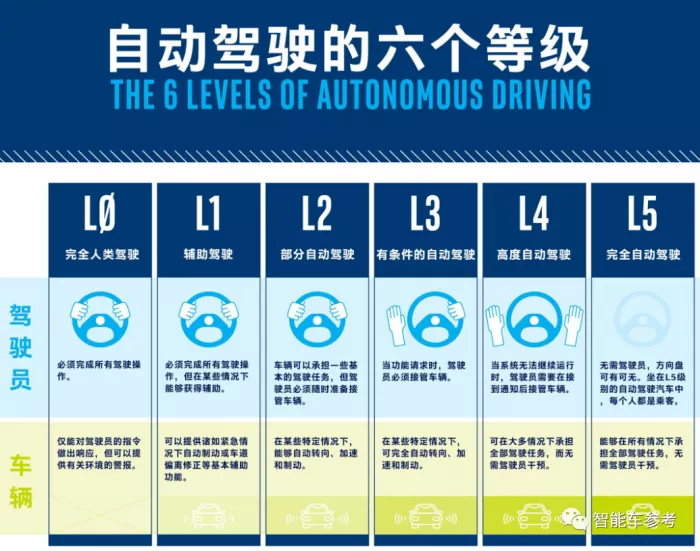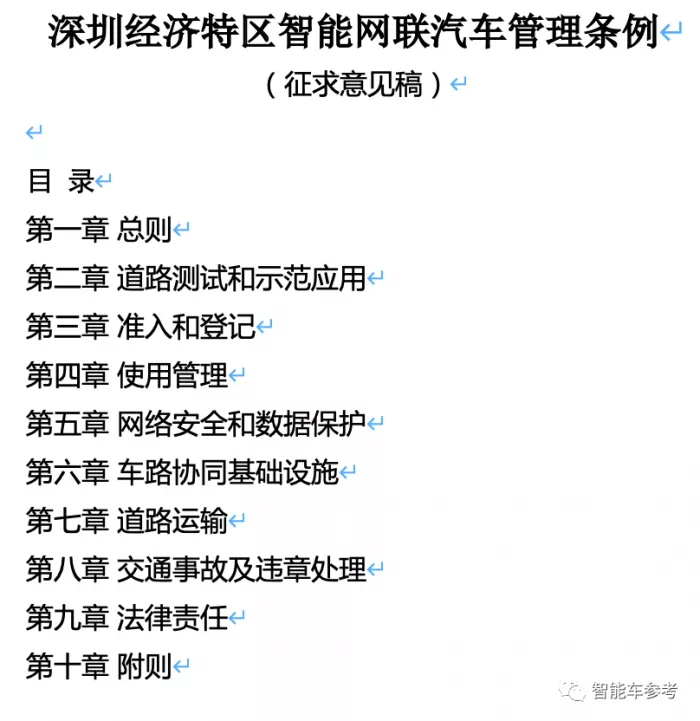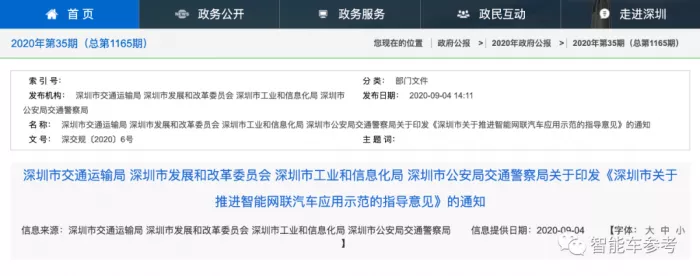The first city in China to open L3 automatic driving is coming. Guangzhou is not the first city of autonomous driving, nor Beijing, which has the world's first high-level autonomous driving demonstration zone. Shenzhen is the first to eat crabs. According to the 2022 legislative plan issued by the Standing Committee of the Shenzhen People's Congress, the regulations of the Shenzhen Special Economic Zone on the administration of intelligent connected vehicles ranked first. Moreover, the regulations have passed the third trial stage before their promulgation, and have been officially issued, leaving only one foot short of the door.

This administrative regulation is the first official administrative document in China to divide the rights, responsibilities, definitions and other important issues of L3 and above autonomous driving in detail, removing policy obstacles for vehicles that have achieved conditional autonomous driving to start on the road legally.
What is more significant is that the promulgation of the administrative regulations provides standards and templates for L3 level automatic driving access policies in other parts of the country.
The general mood is open. L3 level automatic driving is on the road legally, and it is about to come out.
What kind of regulations?
The regulations of the Shenzhen Special Economic Zone on the administration of intelligent connected vehicles have 10 chapters and 60 articles, covering specific provisions and management measures from the definition of automatic driving of intelligent connected vehicles, market access, to the identification of right of way and rights and responsibilities.
The most noteworthy aspects are as follows:
First of all, it is a detailed definition of the automatic driving of intelligent connected vehicles:
Intelligent connected vehicle refers to a new generation of vehicles that are equipped with advanced on-board sensors, controllers, actuators and other devices, and integrate modern communication and network technologies to realize the exchange and sharing of intelligent information between vehicles, roads, people and the cloud. It has the functions of complex environment perception, intelligent decision-making and collaborative control, and can realize safe, efficient, comfortable and energy-saving driving, and can finally replace human operation. Automatic driving of intelligent connected vehicles includes three technical levels: conditional automatic driving, highly automatic driving and fully automatic driving.
From the explanation of terms of three types of automatic driving in the regulations, they respectively correspond to L3, L4 and L5 levels of automatic driving.

Especially for L3 level automatic driving, the regulation points out that the auto drive system can perform all dynamic driving tasks within the designed operating conditions, and the driver can perform dynamic driving task takeover in an appropriate manner.
To be clear, you can get rid of driving, but you need to take over at any time if necessary.
Secondly, the test and demonstration application conditions. There are three keywords: test area, driver arrangement, and road definition.
The provisions on the test area are that road sections, areas and time periods are selected for testing on the premise of ensuring public safety. At the same time, in the district level administrative regions with relatively complete vehicle road coordination infrastructure, the whole area can be opened for road testing after applying for the evaluation procedure.
In terms of driver arrangement, according to different levels, L3 level automatic driving test needs to arrange drivers, and L4 and L5 level automatic driving test can be conducted without drivers after safety assessment and review, that is, completely unmanned test.
Test roads include expressways, urban expressways, open roads and other roads that allow social vehicles to pass. This definition field is unprecedented broad.
Thirdly, the regulations on commercial operation.
The regulations stipulate that relevant fees can be charged for using intelligent connected vehicles to engage in road transport business activities, and encourage intelligent connected vehicles to provide customized travel, community travel, night vehicles, emergency support and other diversified services.
Simply understand, no matter whether the autonomous vehicle carries people or goods, it can be charged. The setting at the edge of the commercialization of autonomous driving is the first in the country.
Finally, it is also the core issue of L3 automatic driving: ownership of rights and responsibilities.
If an intelligent connected vehicle equipped with a driver commits traffic violations, the traffic management department of the public security organ shall punish the driver according to law; If a traffic accident occurs and one party of the intelligent connected vehicle is responsible, the driver of the vehicle shall bear the corresponding liability for damages; If a traffic accident is caused by the quality defect of the intelligent connected vehicle, the driver may recover the compensation from the manufacturer and seller of the intelligent connected vehicle after assuming the liability for damages according to law.
In other words, as long as the L3 level auto drive system is turned on, the driver will always be the first responsible person for any violation or accident caused by his own vehicle.
In addition to clarifying responsibilities, the greater value of this provision lies in that a core issue that puzzles OEMs and consumers has been answered in domestic official documents for the first time.
The above four key messages release an important message: L3 level automatic driving, which used to be in the fuzzy field, can be legally on the road, and it is also the whole scene of high-speed, urban open roads and parking areas.
Although only some areas are open at present, the scene is more open than the L3 level automatic driving policy issued in other parts of the world.
For example, Germany and Britain have only opened expressways and urban expressways, and the use scenario is limited to congested sections with a speed of less than 60 kilometers per hour.
In addition to the most noteworthy parts above, the regulations of Shenzhen Special Economic Zone on the administration of intelligent connected vehicles covers an unprecedented depth and breadth.
Let's talk about the depth first. The regulations can say that there are no details. It not only makes specifications in the general direction, but also comes up with specific solutions.
Taking the legal responsibility part as an example, the regulations stipulate that the Municipal Industry and information technology department will not handle the subject who violates the application for access, conceals relevant information or provides false materials to handle the access of Shenzhen intelligent Internet connected automobile products, give a warning and impose a fine of not less than 500000 yuan but not more than 1million yuan; The applicant shall not apply for the access of Shenzhen intelligent Internet connected automobile products again within one year.
The amount of punishment, the time of prohibition of access, and the specific punishment measures are complete.
The breadth is better understood. In addition to the general provisions and the final explanation of terms, Article 60 in Chapter 10 of the regulation is regulated from eight major directions, covering all aspects of autonomous vehicles from testing to operation, from production to sales, from insurance to rights and responsibilities.

Why is Shenzhen a pioneer?
Compared with Guangzhou, the first city of autonomous driving, and Beijing, which has the world's first high-level autonomous driving demonstration zone, Shenzhen has broken the ice, which is a bit unexpected, but more reasonable.
Because Shenzhen is well prepared in terms of relevant policies and industrial accumulation.
At the policy level, as early as 2018, Shenzhen, led by the Transportation Bureau, formed a joint team for road test of intelligent connected vehicles with multiple departments to promote the implementation of automatic driving.

Later, in 2020, the guidance of Shenzhen Municipality on promoting the application demonstration of intelligent connected vehicles was issued to guide and standardize the implementation of many application fields, such as automatic driving manned, cargo carrying and urban sanitation.
At the end of 2021, Shenzhen solicited opinions from the outside world on the new version of the implementation rules for the management of road test and demonstration application of Shenzhen intelligent connected vehicles, which is expected to be launched in the first half of this year.
A series of policies, from the joint preparation led by multiple departments, to the later standardized application scope of automatic driving, and then to the landing test management, show a law of step by step and deepening the landing degree in stages.
And there is one more thing to note: the uniqueness of Shenzhen Special Economic Zone itself.
As a city with both the legislative power of special economic zones and the legislative power of cities divided into districts, a considerable part of Shenzhen's laws and regulations are first tried in the country. After Shenzhen's experience is mature, they will be gradually extended to other regions in China.
As a brand-new field before landing, it is natural for Shenzhen to take the lead in policy pilot.
In terms of related industries, Shenzhen has also accumulated.
On the one hand, Shenzhen has sufficient technology accumulation, industrial clusters and a number of representative leading enterprises in the fields of three electric systems, automatic driving, chips, digital cockpit and various sensors related to intelligent connected vehicles.
For example, Huawei, BYD, Yuanrong Qihang and other industry representatives are based in Shenzhen.
The autopilot landing test has also been carried out in advance.
According to official data, as of March this year, the whole region of Shenzhen has opened 145 kilometers of intelligent connected vehicle test roads, issued 493 road test and demonstration application licenses, and the world's first large-scale 5g + automatic driving application port has also been launched in Shenzhen.
In Nanshan, Futian, Pingshan and other major areas, robotaxi, autonomous minibuses and low-speed autonomous vehicles have been tested. The test subjects include mainstream players such as Baidu Apollo and Yuanrong.
Therefore, it is logical for Shenzhen to become the first city to finalize L3 level automatic driving on the road in the form of laws and regulations.
What is the meaning of the administrative regulations?
For Shenzhen itself, needless to say, it is of great significance for China to be the first city in China to open L3 level automatic driving in all scenes, which is the first in the country. But more importantly, for the industry and for other regions of the country, this regulation is like a great drought. As far as the industry is concerned, the major OEMs have strong intentions but dare not touch the landing use of L3 automatic driving.
From the perspective of technical level, taking Mercedes Benz drive pilot, the world's first officially calibrated L3 level auto drive system, as an example, it is inferior to the domestic mainstream players, including Xiaopeng and namo Zhixing, in terms of usage scenarios and other aspects.
Especially in the urban open road scene, the major OEMs have started intensive testing since the second half of last year, and the official launch time is also concentrated in this year.
However, domestic head mass-produced auto drive system can only calibrate l2+ to restrict off hand driving.
There are two core reasons: first, the ownership of L3 level automatic driving is not clear; Second, the data security, including the processing of road information and vehicle road coordination data, is not clear.
The above two points are policy issues that need to be solved urgently in the industry. For example, Robin Lee, chairman of Baidu, recently called on the state to introduce more breakthrough innovation policies, speed up the revision of the road traffic safety law, and make L3 / L4 autonomous vehicle legally on the road as soon as possible.
The problems that perplex L3 and even higher-level automatic driving have been carefully answered in the administrative regulations.
It is very timely to introduce policies at this time.
For other parts of the country, as mentioned above, Shenzhen, as a special economic zone, has many policies that are first tried.
The issuance of the administrative regulations is also a policy model room for the later national L3 level automatic driving landing. The experience and lessons learned from the implementation of the policy can greatly accelerate the process of automatic driving landing.
Maybe it will become a reality soon, don't you think?